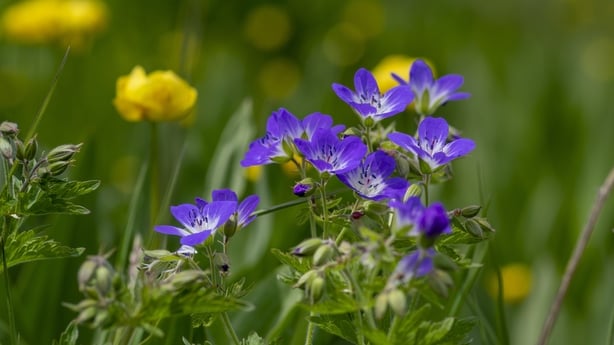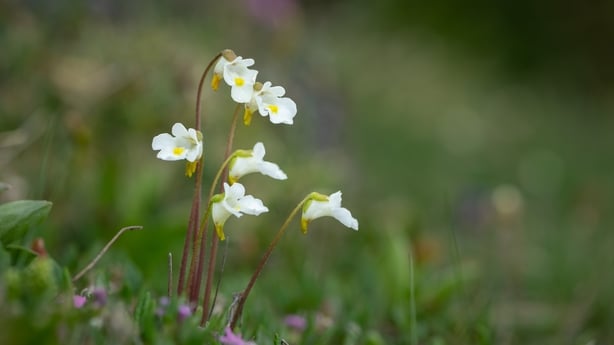Analysis: Research has found the Nettle-leaved Bellflower and five other native plants are at risk of extinction due to climate change
From extreme weather events like flooding and forest fires, to allergies and asthma, climate change has far-reaching effects, including on our native flora. Recent Irish research has found the Nettle-leaved Bellflower and several other native plants are at risk of extinction due to climate change.
UCC researchers modelled 13 of Ireland's most vulnerable and endangered plant species and found that based on models of projection, six of them are at risk of extinction in a "relatively short" time frame. These are: the Nettle-leaved Bellflower (C. trachelium), Mackay's Heath (E. mackaiana), Wood cranesbill (G. sylvaticum), Alpine Butterwort (P. alpina), Subterranean Clover (T. subterraneum) and Spring Vetch (V. lathyroides).
"We wanted to see how climate change might impact some of our most vulnerable plants, species, as well as some of our non-native deer species, and see how their geographic ranges might shift or change as climate shifts and changes across the island," said Dr Paul Holloway, lecturer in Geography and Ecology at UCC.
We need your consent to load this rte-player contentWe use rte-player to manage extra content that can set cookies on your device and collect data about your activity. Please review their details and accept them to load the content.Manage Preferences
From RTÉ News, Rare plant spotted in Killarney National Park for first time since 1896
The researchers also identified an expansion in the range of the non-native sika deer in Ireland, which is "potentially bad news for our native plants - because obviously they're herbivores and they eat a wide range of plants and leaves and saplings," Holloway said, while speaking on RTÉ Radio 1's Drivetime. The geographic area the sika deer cover is also projected to increase across the country.
How quickly could the plants become extinct?
The research showed it could take "a good 50 years" for the plants to become extinct. "Our models were projected to 2070, which is perhaps 2070 to the 2100 range, so a good 50 years away. Not immediately, which is quite a good thing really, because it provides us with an early warning system to say, 'OK, these are the plants that are at risk and we have time to to do something about it'," he explained.


What happens if they become extinct?
Ecosystems are so entwined that if you lose one species it completely throws it out of balance. "Ultimately, if you lose one plant species it puts the dependence on other plant species for our native herbivores that are feeding off of that. But also so too our pollinators, and our bird species, and the whole ecosystem that's working with that. So not just having a healthy biodiversity on the island, but also everything that brings with it, our natural and cultural heritage that's associated with Ireland," he said.
Read more: How the curlew bird became Ireland's poster child for extinction
"When you have systems that are so degraded and become dominated by one or two individual species, that's a real risk in itself. That's when, if something was to happen such as disease spread, it can really catastrophically damage what those ecosystems are. So having that diversity of species is imperative. When one is doing well, others might be doing less well, but it's peaks and troughs, it goes up and down. Ultimately, being able to have that diversity in different species is important for the overall system."
We need your consent to load this rte-player contentWe use rte-player to manage extra content that can set cookies on your device and collect data about your activity. Please review their details and accept them to load the content.Manage Preferences
From RTÉ Radio 1's Drivetime, UCC's Dr Paul Holloway on the six native plants at risk of extinct due to climate change
50 years isn't a lot of time. What can we do to help?
The research alludes to the fact that urban areas are one location that "could do really, really well, and could provide very suitable climates and suitable habitats," Holloway said. The small scale changes that people are making like not mowing their lawns in May and letting their gardens re-wild are testament to the response to the biodiversity crisis, he said.
"People are planting more native species, we're more tuned into it and that is having a positive effect. We're seeing that natural diversity almost take hold in some of these areas, not just through wildflower meadows, but that leaving the hedgerows to grow, leaving the verges to grow, and that is potentially shifting it as well," he said. "Ultimately, tuning into the issue and starting to ask yourself 'what things can we do to to support this?' is probably the starting point."
Follow RTÉ Brainstorm on WhatsApp and Instagram for more stories and updates
The views expressed here are those of the author and do not represent or reflect the views of RTÉ


